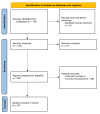From Risk Assessment to Intervention: A Systematic Review of Thrombosis in Plastic Surgery
- PMID: 37554601
- PMCID: PMC10405759
- DOI: 10.7759/cureus.41557
From Risk Assessment to Intervention: A Systematic Review of Thrombosis in Plastic Surgery
Erratum in
-
Correction: From Risk Assessment to Intervention: A Systematic Review of Thrombosis in Plastic Surgery.Cureus. 2025 Aug 26;17(8):c257. doi: 10.7759/cureus.c257. eCollection 2025 Aug. Cureus. 2025. PMID: 40873914 Free PMC article.
Abstract
Thromboembolism is a feared complication in plastic surgery and is linked to higher rates of morbidity and mortality. Despite extensive research, there is a lack of consistency between recommendations and clinical protocols to be implemented pre and post-surgery to reduce the incidence of thromboembolism. A systematic literature review was conducted using Pubmed and Scopus databases to determine the risk factors, screening methods, and existing treatment models for thromboembolism prevention. Articles in non-English languages were excluded. Analysis indicated that predominant risk factors include age (>35), elevated body mass index, coagulation disorders, smoking, estrogen therapies, genetic predisposition, vascular endothelium damage, stasis, and use of general anesthesia in patients with a history of cancer. Implementation of a proper prophylactic protocol is dependent on understanding the interplay between the aforementioned risk factors and the utilization of well-defined, evidence-based guidelines, such as the 2005 Caprini Risk Assessment Model and ultrasound surveillance. The literature review revealed that mechanical prophylaxis is the primary prevention method, followed by thromboprophylaxis for patients with higher Caprini scores. Plastic surgeons often underestimate the present risk stratification tools available for the prophylactic intervention of thromboembolism due to the fear of bleeding or hematoma complications postoperatively. In summary, this literature review emphasizes the importance of plastic surgeons selecting protocols that is inclusive of the patient's risk profile to yield a reduced risk of thromboembolism.
Keywords: caprini risk assessment; intervention; plastic surgergy; thromboembolism; thrombosis.
Copyright © 2023, Patel et al.
Conflict of interest statement
The authors have declared that no competing interests exist.
Figures
References
-
- Ashorobi D, Ameer MA, Fernandez R. Treasure Island (FL): StatPearls Publishing; 2023. Thrombosis. - PubMed
-
- Management of flaps with compromised venous outflow in head and neck microsurgical reconstruction. Kubo T, Yano K, Hosokawa K. Microsurgery. 2002;22:391–395. - PubMed
-
- Randomized trial of deep vein thrombosis chemoprophylaxis with bemiparin and enoxaparin in patients with moderate to high thrombogenic risk undergoing plastic and reconstructive surgery procedures. Revilla-Peñaloza F, Olsoff-Pagovich PJ, Ochoa-Gomez JR, Castaneda-Gaxiola R, Rubio-Gayosso ÁI, Ceballos G, Molina-Guarneros JA. Aesthetic Plast Surg. 2020;44:820–829. - PubMed
-
- Deep venous thrombosis: prevention and management. Iverson RE, Gomez JL. Clin Plast Surg. 2013;40:389–398. - PubMed
Publication types
LinkOut - more resources
Full Text Sources

